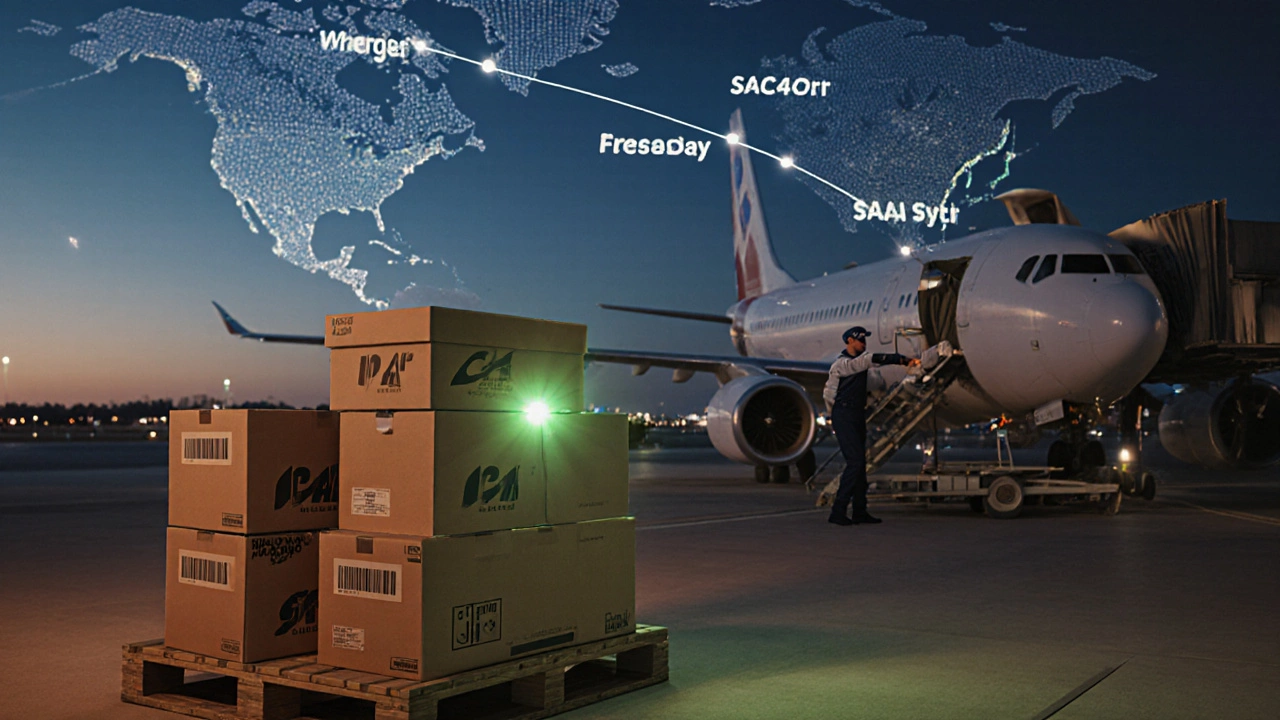Courier Delivery Times: How Fast Can Packages Arrive?

Delivery Time Calculator
Calculate Your Delivery Time
Estimate delivery based on service tier, distance, and current conditions
Estimated Delivery Time
Important: Estimates assume standard carrier conditions. International shipments may take longer due to customs processing.
Key Takeaways
- Standard domestic shipments usually arrive in 2‑5 business days.
- Express options cut the window to 1‑2 days, while same‑day services can be under 12 hours in major metro areas.
- International courier times range from 3‑7 days (express) to 2‑4 weeks (economy), depending on customs and destination.
- Distance, package size, carrier network, and seasonal peaks are the biggest speed drivers.
- Using tracking, proper documentation, and choosing the right service tier can shave days off the journey.
When you send a package, Courier service is a company that transports parcels and documents from one location to another on a scheduled basis determines the courier delivery time based on several variables. Whether you’re a small online retailer trying to promise a delivery window or a busy professional needing a document fast, understanding those variables lets you set realistic expectations and avoid angry customers.
What Exactly Is a Delivery Time?
A delivery time refers to the period between the moment a carrier picks up a shipment and the moment it reaches the recipient’s door. It’s not a static number; it shifts with every change in distance, service level, and external conditions. For most carriers the quoted “delivery window” is a best‑case estimate, and they often guarantee a refund if they miss it under specific terms.
Typical Delivery Windows by Service Type
Couriers usually group their offerings into four broad tiers. Below is a quick snapshot of how long each tier typically takes for domestic shipments in the United States and the United Kingdom, the two markets with the most granular data.
| Service Tier | Typical Transit Time (Domestic) | Cost Relative to Standard | Best Use Cases |
|---|---|---|---|
| Standard | 2‑5 business days | Base price | Non‑urgent parcels, low‑value items |
| Express (2‑Day) | 1‑2 business days | ~1.5× standard | Time‑sensitive e‑commerce orders, replacement parts |
| Same‑Day | Under 12 hours (major metros) | ~2.5× standard | Urgent documents, medical supplies, intra‑city deliveries |
| International Express | 3‑7 days | ~3× standard | Cross‑border e‑commerce, sample shipments |
Factors That Influence Courier Delivery Speed
Even within a single tier, real‑world delivery times can vary. The most common influencers are:
- Geographic distance. Shipping coast‑to‑coast in the U.S. adds at least one extra day compared to intra‑city moves.
- Carrier network density. Couriers using a hub‑and‑spoke model may need an extra sorting stop, while those with a direct line‑haul can shave hours.
- Customs and regulatory clearance. For international parcels, paperwork errors can add 2‑5 days.
- Package size and weight. Oversized items sometimes require special handling, which can delay the last‑mile leg.
- Weather and natural events. Snowstorms, hurricanes, and even severe heat waves can temporarily suspend air or ground routes.
- Peak season volume. The weeks surrounding Black Friday, Christmas, and Chinese New Year typically see a 10‑20% increase in transit times.
How to Estimate Your Shipment’s Arrival
Most carriers provide a simple calculator on their websites. If you need a quick estimate without logging in, follow these steps:
- Identify the service tier you plan to use (standard, express, etc.).
- Measure the distance between origin and destination. Online distance tools give you “as‑the‑crow‑flies” miles; add 15‑20% to account for actual road routing.
- Add a buffer based on known influences:
- +1 day for cross‑border shipments.
- +1‑2 days for peak season (Nov‑Dec, July‑Aug in Asia).
- +0.5 day for weather alerts in the origin or destination region.
- Check the carrier’s tracking system for real‑time updates; most offer a projected “delivery date” that auto‑adjusts.
Using a spreadsheet, you can turn these rules into a reusable formula: Estimated Days = Base Tier Days + Distance Buffer + Seasonal Buffer + Weather Buffer.
Ways to Speed Up Delivery
If the default window doesn’t meet your deadline, you have a few levers to pull:
- Upgrade the service tier. Moving from standard to express often shaves a full day.
- Pay for priority handling. Many carriers offer “priority sorting” for a small surcharge.
- Choose the right carrier. For same‑day urban deliveries, a local courier (e.g., Roadie, Postmates) can be faster than a national carrier.
- Prepare perfect documentation. International shipments lose time at customs when invoices are missing or mislabeled.
- Use a nearby drop‑off hub. Bypassing a residential pick‑up can reduce the first‑mile delay by a few hours.

Common Pitfalls and How to Avoid Delays
Even with the best carrier, simple mistakes can push a shipment into the next day:
- Incorrect address. A missing apartment number or misspelled street can send the parcel to a dead‑end.
- Unclear labeling. Handwritten labels are still common, but a smudged barcode may force a manual scan, adding minutes to each checkpoint.
- Undeclared value. Some carriers require customs value declarations; without them, the package is held for inspection.
- Packaging violations. Oversized or irregularly shaped parcels might need special freight, which is scheduled less frequently.
- Late pick‑up requests. Scheduling a courier pickup after the carrier’s cut‑off time often pushes the shipment to the next business day.
Double‑check the address, use a printable label with a clear QR code, and verify that any required paperwork (commercial invoice, export license) is attached before handing the package to the driver.
Real‑World Example: From Warehouse to Customer in 24 Hours
A medium‑size e‑commerce shop in Chicago wanted to guarantee next‑day delivery to Los Angeles for a new sneaker launch. Here’s what they did:
- Selected an express courier that offered a guaranteed 1‑day air service.
- Used the carrier’s integrated API to generate a pre‑paid label with a barcode that included the tracking number.
- Packaged the sneakers in a standardized box that met the carrier’s “no‑re‑handle” requirement.
- Configured the warehouse management system to trigger a “same‑day pick‑up” request before the carrier’s 2 PM cut‑off.
- Monitored the live tracking feed; when the package hit the hub in Denver, they received an automatic SMS confirming the next‑day ETA.
The result? 99% of orders landed at the customers’ doors before 9 PM the next day, and the brand recorded a 12% boost in repeat purchases. The lesson? Aligning the right tier, technology, and packaging can reliably shrink the delivery window.
Frequently Asked Questions
How can I track the exact time a courier will deliver my package?
Most major carriers provide a real‑time tracking portal that shows the current status, estimated arrival window, and any exceptions. If you’ve signed up for notifications, you’ll receive SMS or email alerts whenever the package moves between hubs.
Do weekend deliveries count as part of the courier delivery time?
It depends on the service tier. Standard domestic shipments often exclude weekends, so a “5‑day” window may actually span seven calendar days. Express and same‑day options usually include Saturdays, and some carriers now offer Sunday delivery for a premium.
Is there a way to guarantee delivery on a specific date?
Yes. Many couriers sell a “date‑guaranteed” service that includes a money‑back promise if the package arrives late. This usually costs 20‑30% more than the standard express rate and requires full compliance with the carrier’s packaging and documentation rules.
Why does my international shipment take longer than the quoted time?
Customs clearance is the biggest wildcard. Missing or incorrect paperwork, duties that need to be paid, or random inspections can add 2‑5 days. Using a carrier’s customs brokerage service and providing a detailed commercial invoice reduces the risk.
Can I speed up delivery by choosing a different drop‑off location?
Often, yes. Dropping the parcel at a carrier‑run hub instead of a residential pick‑up bypasses the first‑mile scheduling step. Some services even let you drop off at partner retail stores for an extra‑fast “store‑to‑door” leg.